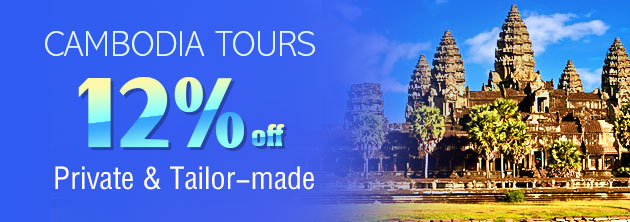A Short Break at Ta Som Temple
Cambodia is mostly known around the world for being home to the ancient city of Angkor. Angkor has some of the world’s most stunning temples. While the main Angkor Wat temple complex is the focal point of tourist attraction, there are several other temples that deserve your attention.One such temple is the Ta Som. Compared to the most prominent Angkor temples, Ta Som has remained somewhat in the shadows. However, Ta Som still has much to offer to those who are interested in gaining valuable insights into the architectural brilliance and prowess of the Khmers of the ancient Angkor Empire.
Where is Ta Som?
The temple of Ta Som is situated quite close to one of the Angkor Empire’s most cherished architectural feats, the Neak Pean temple. While Neak Pean is situated right in the center of the Jayatataka Baray (a man-made water reservoir in Angkor Wat), Ta Som is located at the reservoir’s eastern edge.Architectural Highlights of the Ta Som Temple
The Ta Som temple has many architectural features to boast of. Some of them are:• Lokesvara Carving: As you enter the temple, you will be greeted by an absolutely immaculate carving of the Bodhisattva Lokesvara on the walls. The carving features Lokesvara in a standing position, stretching his arms out. Alongside his carving, you would witness some carvings of the devotees of Lokesvara.
|
|
|
• Lintels and Pediments in the Central Sanctuary: The central sanctuary of the temple is home to some of the most awe-inspiring carving work that you would ever see. The carvings here include depictions of deities and scenes from both Buddhist and Hindu folklores.
Who Built the Ta Som?
The temple dates back to the late 12th century when King Jayavarman VII commissioned its construction. Historians have revealed that the then-ruler of the Angkor Empire dedicated the temple to his ancestors.Is it a Hindu Temple?
While King Jayavarman VII was a Hindu ruler, he built the Ta Som temple for both Buddhists and Hindus. This is evident from the pediments and lintels found in the inner sanctuaries of the temple, which mostly featured scenes from Buddhist folklores but capture several famous scenes from Hindu mythology as well. The towers of the temple feature faces of Bodhisattva Lokesvara, which is the further proof of the fact that it was a Buddhist temple built in a time when Cambodia was predominantly Hindu.Interesting Facts about Ta Som
• The temple was added to the list of monuments featured in the restoration program of the World Monuments Fund in 1998. The aim was to stabilize the temple’s structure to ensure safety for visitors.
• The construction material that was primarily used to build this temple was laterite, a rock that is commonly found in hot and humid tropical regions.
• King Jayavarman II’s architectural style can be witnessed in this temple due to the presence of ‘face towers’, which feature prominently in most of the once-mighty Angkor ruler’s commissioned temples.

Laterite Constructions in Ta Som Temple
|
How did the world come to know about Ta Som?
When it was at the peak of its powers, the Angkor Empire was second to none. However, the abandonment of the Angkor city left it to be forgotten on the pages of history. It was only in the 1930s that a renewed interest in Angkor and its ancient culture and history led to explorers finding the truly brilliant and mysterious temples of the ancient city, including Ta Som.
Read More: Angkor Wat History Why Was Angkor Wat Abandoned?
The abandoned city of Angkor witnessed a rapid growth of natural vegetation. When explorers and conservators found Ta Som, it was, like all the other temples in Angkor, covered in thick overgrowth. On witnessing the beauty of the temple first-hand, conservators wasted little time in clearing the vegetation and restoring the temple to a state where it somewhat resembled its former self.
Best Time to Visit Ta Som
As the winter months remain the most pleasant in terms of weather in Cambodia, they are the months during which Cambodia witnesses maximum tourist influx. You may be in for a rough ride if you are a backpacker sort of traveler as almost everything is overpriced during these months.If you want to experience the captivating Ta Som temple at its finest, then you should ideally visit it in either summer or monsoon, when Cambodia witnesses a drop in tourist footfall.
How to Reach Ta Som Temple?
From the Siem Reap International Airport, you need to cover a distance of almost 18 km (11.2 miles) to reach Ta Som. There are a few transport options available that include:• Taxis: A $25-50 USD tour on a private taxi can take you across all the major temples in the Angkor Archaeological Park, including Ta Som.
• Tuk-tuks: Cambodia’s most popular local transport offers tours of all the famous Angkor temples in the range of USD 15-25.
• Bicycles: You can rent bicycles in the range of USA$1-5 (daily rental) and pick from bicycles such as city bikes, speed bikes and mountain bikes.
If you are looking forward to spending a few days in a place that is full of natural beauty and cultural heritage, then you should definitely consider the temples in South-East Asian country of Cambodia. Its glorious past has gifted it with a plethora of places that make travelers all over the world curious.
Nearby Attractions:
East Mebon Temple Neak Pean


